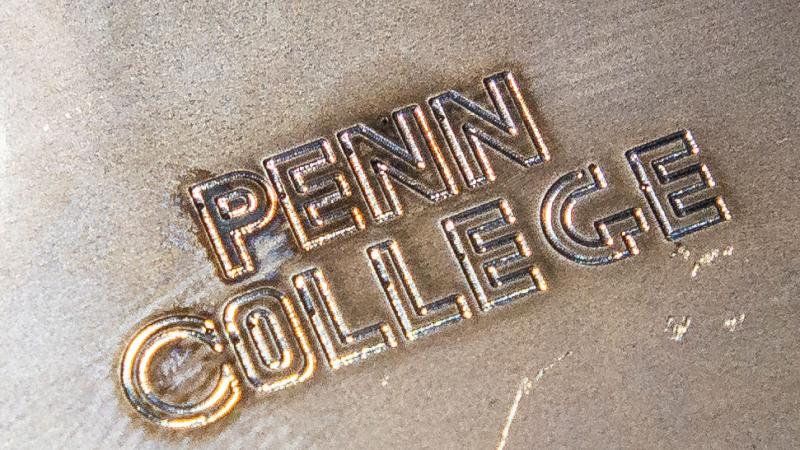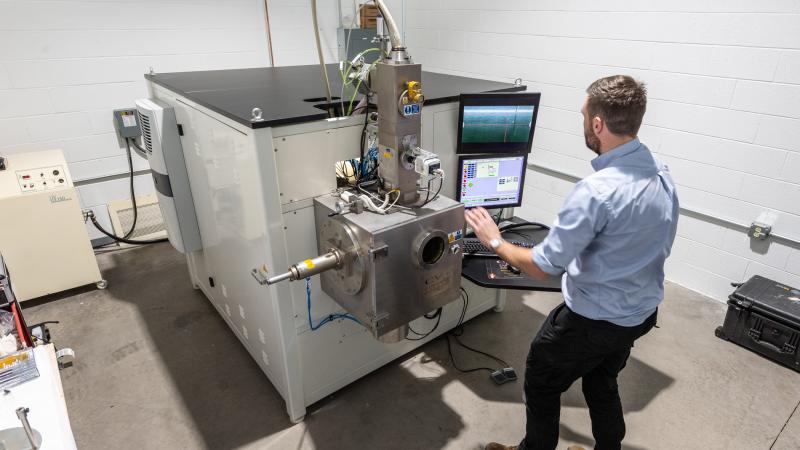A newly joined pair of pipes are seated in the college’s new 60kV electron beam welder. Instead of using a filler material, the heat from high-speed electrons melts and joins the materials, providing for a very thin welding bead.
Electron beam welder becomes first
Published 02.26.2020
by Jennifer A. Cline, writer/magazine editor, with reporting by Tom Speicher, writer/video producer; photos by Larry D. Kauffman
In January, Pennsylvania College of Technology became the first educational institution in the United States to house an electron beam welder.
“EB” welding is used in a wide variety of industries, including aerospace, automotive, energy, nuclear and sensor technology. As of 2013, the American Welding Society estimated there were 3,000 electron beam welders in operation throughout the world.
The process can produce very thin welds that can range from one-thousandth of an inch to 2 inches deep. The resulting bead is so thin, explains Michael R. Allen, instructor of welding and co-head of the department, that it requires a magnifying glass to see the detail. The process also provides efficient energy transfer, which results in low heat output and makes it safe to seal sensitive internal electronics packages into devices.
Students are eager for it to become part of their hands-on education.
“The thing that excites me most about Cambridge Vacuum Engineering’s electron beam welder is that it will raise the bar, academically, for Penn College welding students,” said Nathaniel H. Lyon, a senior pursuing a bachelor’s degree in welding and fabrication engineering technology. “To gain a mastery of any process, it's important to understand how that process works. Well, with EB welding, there are some exciting physics principles involved that I think will push students outside of their critical-thinking ‘comfort zones’ – and that's where real learning happens!”
The 60kV welder resides in a dedicated lab within the addition to the Lycoming Engines Metal Trades Center, which opened to students in the fall and was dedicated in February. The expansion nearly doubled the center’s instructional space and allowed the college to accept more welding students in Fall 2019, eliminating the popular program’s traditional waiting list. Construction of the 35,000-square-foot facility was funded in part by a $2 million grant from the U.S. Department of Commerce.
The added space is well-equipped with leading technology, thanks to 21 corporations that provided more than $2.5 million in equipment value through entrustments, discounts and donations, plus cash commitments from corporations, alumni and friends.
The new equipment, which includes the electron beam welder, a laser welder, and many other industry-standard technologies, not only expands learning opportunities for students but also further benefits companies that had already been scrambling to hire the college’s real world ready welding graduates.
The electron beam welder was acquired through a partnership with Cambridge Vacuum Engineering, of England. The company attests that Penn College is the first educational institution in the U.S. to acquire one of its EB welders.
“Industry has been calling us and asking us if our students have any training on this type of equipment,” Allen said. “Now we can actually say, ‘Yes.’”
Each year, more than 200 Penn College students will gain hands-on experience with the EB welder.
“I have read job postings that asked for experience in electron beam welding,” the soon-to-graduate Lyon said. “That used to be a little intimidating, but it won't be for long.”
“Giving them (students) the opportunity to have hands-on exposure to this stuff I think is going to bring them to a whole new level, and it’s going to take us with them,” said Ryan P. Good, assistant professor of welding.
Good, Allen and four other welding faculty members received training on a similar welder in Massachusetts before the college’s equipment was delivered. After a day and a half of instruction, Tony Slater, technical sales manager for Cambridge Vacuum Engineering, gave the group a quiz.
“They scored higher than I’ve seen anyone do before,” Slater said.
Slater was the driving force within Cambridge Vacuum Engineering for the placement of the welder at Penn College.
“After visiting (Penn College), I realized they are forward thinking, and their attitude toward the students would be a perfect match for us,” Slater said.
The expansion of the Penn College welding lab has also brought the addition of a laser welding cell, a dedicated CNC robotic welding lab, an air pressure-controlled specialized welding room, additional capabilities and space for non-destructive testing, rigging and crane operations for work with larger parts, expanded space for pipe welding, and a space for hands-on training in Occupational Safety and Health Administration standards.

How electron beam welding works
- Parts are loaded into fixtures that will hold them securely in place throughout the welding process.
- The fixtures are attached to a computer numerical control table that is programmed to precisely move parts into position during the welding process.
- An electron gun generates electrons that move at velocities up to two-thirds the speed of light.
- Electrical fields accelerate the speed of the electrons.
- Magnetic fields focus the high-speed stream of electrons.
- As the electrons impact the materials to be joined, their energy is converted to heat.
- The materials melt and flow together.
- Welding occurs inside a vacuum chamber, which prevents air from diffusing the electrons. The walls of the chamber absorb the X-rays that are a byproduct of the welding process.



Share your comments
Penn College Magazine welcomes comments that are on topic and civil. Read our full disclaimer.
We love hearing from you